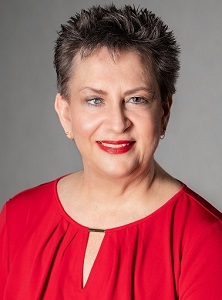According to Cognitive Behavioural Therapy (CBT), how you think affects how you feel, and how you feel influences your behaviour.
For example, if we think we that we’re sad or depressed, our shoulders may slump, our head goes down, our movements may slow down and we then behave like a sad or depressed person. (NB When I say depression here, I am referring to feeling down, not the much more serious mental illness, clinical depression.)
On the flip side of the CBT coin is the notion that if you think realistic, helpful thoughts, your mood will be better and you will function better. This is a very simplistic explanation of CBT.
The below example of someone who fears public speaking (which is one of the most common fears people have) illustrates the interaction between thoughts, physical symptoms and behaviour.
Unhelpful Thought
“This is going to be a disaster. I’m hopeless at public speaking. I’ll blush and sweat, and everyone will see I’m anxious and think I’m an idiot.”
Physical Symptoms
You start to sweat and your heart begins to pound.
Unhelpful Thought
“I feel so anxious. I must look really nervous. I’ll make a total fool of myself.”
Physical Symptoms
You sweat even more profusely, your chest feels like it’s about to explode.
Unhelpful Thought
“I can’t do this. I’ve got to escape.”
Behaviour
You leave the building and as you walk away, your anxiety subsides.
Unhelpful Thought
“I’m a loser. Everyone else can do public speaking.”
Remember that I said that fear of public speaking in one of the most common fears that people all over the world have. Even people who speak in public often, can feel nervous and anxious before ‘performing’. This is normal. So how do these people do it well and seemingly easily? The short answer is that they manage their thoughts, thus managing their physical symptoms and consequently, their behaviour.
A therapist using CBT will ask what situations are anxiety-provoking for you. The therapist will then want to know what you usually think and do in these situations.
The therapist will help you to identify your unhelpful thoughts and beliefs; evaluate evidence for and against your thoughts and beliefs; create more realistic statements you can say to yourself when anticipating or confronting feared situations as these will decrease the degree of anxiety you experience; and devise a plan for gradually exposing yourself to your feared situations.
The therapist will also help you to identify your problematic behaviours (eg poor eye contact, fidgeting, mumbling) and help you to develop strategies to help you to cope with your physical symptoms of anxiety. Your therapist may also provide and/or recommend books, handouts, videos, apps etc, as part of your treatment.
Cognitive Behavioural Therapy includes the following components:
- Education about mental issues;
- Cognitive therapy;
- Exposure therapy (both imagined and ‘real life’ situations);
- Relaxation training (eg progressive muscle relaxation);
- Breathing techniques (eg diaphragmatic breathing).
CBT may also be used to work on other mental health issues such as social anxiety, low self-esteem and lack of assertiveness. Your therapist is also likely to recommend physical exercise and attention to nutrition and lifestyle issues; this is because our mental and physical health states are strongly interconnected.
 Author: Merryl Gee, BSocWk, AMHSW, MAASW, MACSW, MANZMHA, MPACFA.
Author: Merryl Gee, BSocWk, AMHSW, MAASW, MACSW, MANZMHA, MPACFA.
Merryl Gee is a psychotherapist working from a strengths-based, person-centred framework. With over 30 years’ experience, she has a particular interest people who have experienced trauma such as sexual assault or childhood sexual abuse.
To make an appointment with Brisbane Psychotherapist Merryl Gee try Online Booking. Alternatively, you can call M1 Psychology Loganholme on (07) 3067 9129 or Vision Psychology Wishart on (07) 3088 5422 .
